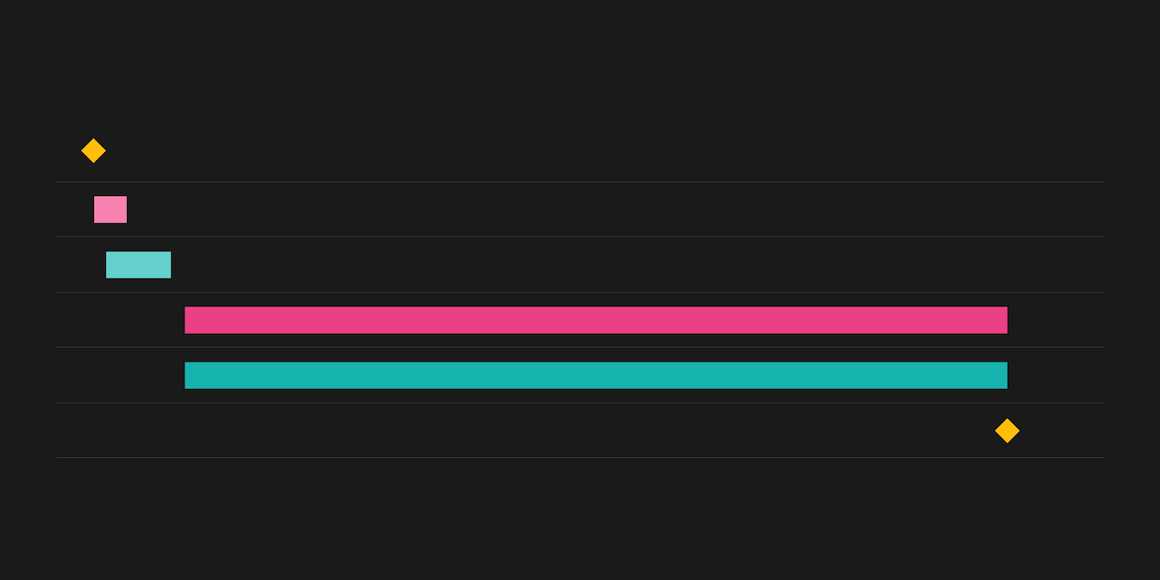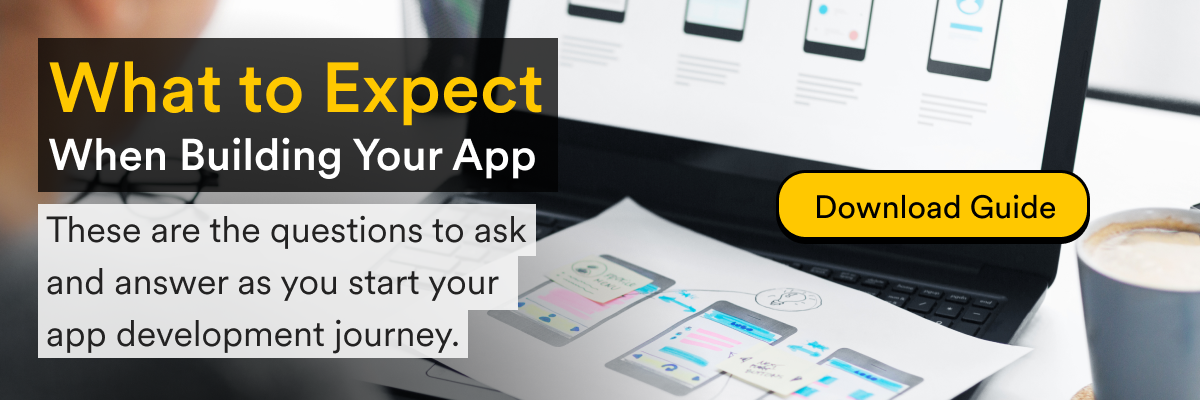
Building an app is a process that takes time and requires you to approach the project from multiple angles. What problem will your solution solve? How should it work? Who will it benefit most? And what type of app do you want to build? Creating a new app is a big enough challenge for any business, but it is very manageable when you follow a tried-and-true app development timeline.
All in all, apps take an average of 4-8 months to launch, depending on the scope of work and complexity. Let’s get familiar with the different elements of app development and how they impact your timeline.
Download our guide, What to Expect When Building Your App. >>
Discovery phase
Kick things off with the discovery stage. This weeks-long planning process lays the groundwork for your project.
Define the way forward
Think of discovery like dumping puzzle pieces out of a box and formulating a plan to put them all together. Discovery provides a jumping-off point to define:
- Project goals
- Scope of work
- Deadlines
- User experience needs
- A plan for building the app
But that’s just the beginning. Once you complete discovery, you’ll spend most of the project designing and building your product, and you need to understand users to do that.
User research
What’s your motivation for creating a new app? To make it in the competitive digital landscape, you need a purpose and understanding of what you want to accomplish. This boils down to taking the time to understand the who, what, and why of the app you’re building—and user research can uncover the answers.
Research process
Methods might differ slightly from company to company, but most developers generally follow time-tested research processes to point your project in the right direction. At Detroit Labs, we embed research and design together, enabling designers to participate while simultaneously working on the user experience (UX).
You’ll also want to interview potential users and use secondary research—research you’ve already invested in—to reveal actionable insights.
User research is the key to satisfying everyone involved with your app. That’s because it:
- Guides user experience design.
- Informs development.
- Maintains alignment among stakeholders.
Product roadmap
With user research in hand, the real work begins. A product roadmap outlines the vision, direction, priorities, and progress of a product over time. You can create yours by following a few simple steps to craft a product roadmap:
Strategy
Developing an app because you think you should or to keep up with the Joneses shouldn’t be your only motivator. In the strategy phase, take the time to ask: “What is my ‘why’?” Hopefully, you already have some idea of what’s driving your project. But if not, outlining your strategy helps determine the reason for the product, whether it’s filling a need or improving on what the competition has put out.
Research
Coming up with a winning strategy can’t be a guessing game. Instead, pair it with more of your new favorite word: research. This time, look at everything from potential users to the market to inform your “why.” Here are some potential tactics:
- Assess market trajectories
- Create value propositions
- Assemble audience demographics
- Develop user stories
- Define effort constraints
By taking these steps, you’ll gain more insight into your vision, objectives, and strategy, informing both the product and its app development timeline.
Goals
If you don’t clearly define your goals for the project, it might be hard to see how and where you are (or are not) making progress. That’s why app development (typically) relies on specific, measurable, attainable, relevant, and time-based (SMART) goals:
- Specific: Define what you want to accomplish, who’s responsible for it, and the steps needed to achieve your goal.
- Measurable: Make sure your goals are trackable so you can reach the finish line by hitting certain benchmarks.
- Attainable: Is your goal realistic? Reflect and decide if you need to take a step back and adjust.
- Relevant: Does your goal tie back to the app you’re building? Will it inform your success?
- Time-based: Hold your team and developers accountable by establishing and adhering to specific timelines.
With SMART goals, it’s easier to define success metrics and identify team member roles and responsibilities.
Initiatives
Once you know what you want to accomplish, figure out how to get there. Your initiatives should help you refine product features and requirements so stakeholders know how each release and feature relates to specific strategies and goals. And at this point, no voice is too big or small. Review and manage ideas from both customers and customer-facing team members to get your product on the fast track.
Winning results: Your MVP
Your MVP is the culmination of months of hard work and is built out enough to validate your solution and inform the next iteration of your product. Arriving here means you’ve conducted enough discovery and research to understand the problem and a potential solution, taken steps to build the ideal solution, and followed proven processes for delivery.
Launch
Once your app is ready to roam the wild, your developers work to get it launched, defining and executing priorities along the way. This part of the app development timeline might include fixing bugs that interfere with usability and experience, signing off on the codebase that makes your app work, and undergoing acceptance testing. That last piece is crucial because it opens your solution to internal and external users. This way, you can collect feedback to ascertain product viability, determine changes for the wider market, and refine your app throughout the product life cycle.
But your development partner never leaves you hanging. In fact, they ensure you have the tools for continuous success, providing essential deliverables such as:
- Hosting support
- Post-launch synopsis and improvements
- Custom source code
Building a new app can be a labor of love, but it takes time and effort. Following a trusted app development timeline can get you from idea to MVP.
Follow an app development timeline to launch your app
Discovery, user research, roadmapping, and all the pieces that make these steps work are vital to getting your app off the ground. App development isn’t a race, so don’t cut corners! You may end up with a product that falls short of expectations and gets edged out by an alternative. Take the right steps throughout the app development timeline to produce an end product that users can trust. Generally, here’s how long you can expect to spend in each of these steps:
- Onboarding: 2 weeks
- Discovery: 2-4 weeks
- UX/UI Design: 3+ months
- Development: 3+ months
Want to know how to get started? Get in touch! And don’t forget to subscribe to the Detroit Labs blog to learn more ways technology solutions can elevate your business.
